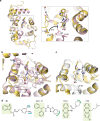Insights into real-time chemical processes in a calcium sensor protein-directed dynamic library
- PMID: 31243268
- PMCID: PMC6595003
- DOI: 10.1038/s41467-019-10627-w
Insights into real-time chemical processes in a calcium sensor protein-directed dynamic library
Abstract
Dynamic combinatorial chemistry (DCC) has proven its potential in drug discovery speeding the identification of modulators of biological targets. However, the exchange chemistries typically take place under specific reaction conditions, with limited tools capable of operating under physiological parameters. Here we report a catalyzed protein-directed DCC working at low temperatures that allows the calcium sensor NCS-1 to find the best ligands in situ. Ultrafast NMR identifies the reaction intermediates of the acylhydrazone exchange, tracing the molecular assemblies and getting a real-time insight into the essence of DCC processes at physiological pH. Additionally, NMR, X-ray crystallography and computational methods are employed to elucidate structural and mechanistic aspects of the molecular recognition event. The DCC approach leads us to the identification of a compound stabilizing the NCS-1/Ric8a complex and whose therapeutic potential is proven in a Drosophila model of disease with synaptic alterations.
Conflict of interest statement
The Spanish National Research Council and the Biomedicine Research Foundation of Ramon y Cajal Hospital have filed the patent applications (P201830933 and EP19382242.6) with the Spanish Patent Office on the use of the compounds described in the paper as synaptic modulators. R.P.-F., A.C.-M., A.Mansilla and M.J.S.-B. are listed as inventors. The remaining authors declare no competing interests.
Figures









References
-
- Brady PA, Sanders JKM. Thermodynamically-controlled cyclisation and interconversion of oligocholates: metal ion templated ‘living’ macrolactonisation. J. Chem. Soc., Perkin Trans. 1997;1:3237–3253. doi: 10.1039/a703390g. - DOI
-
- Hasenknopf B, et al. Self-assembly of tetra- and hexanuclear circular helicates. J. Am. Chem. Soc. 1997;119:10956–10962. doi: 10.1021/ja971204r. - DOI
Publication types
MeSH terms
Substances
LinkOut - more resources
Full Text Sources
Molecular Biology Databases

